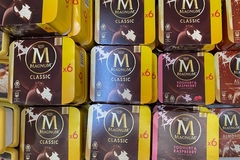
- Industry news
Industry news
- Category news
Category news
- Reports
- Key trends
- Multimedia
- Journal
- Events
- Suppliers
- Home
- Industry news
Industry news
- Category news
Category news
- Reports
- Key trends
- Multimedia
- Events
- Suppliers
Cargill opens “world of protein under one roof,” boosting chicken concepts and AI for animal welfare
29 Sep 2023 ---Cargill has upgraded its chicken specialty facility in Saint-Cyr-en-Val, France with a latest Protein Innovation Hub to enable customers to co-create protein-rich menu strategies. The site enables innovation in protein categories, including but not limited to chicken and incorporates a pilot plant to test new products and concepts.
The global food cooperation giant’s French plant has operated for 30 years and supplies over 2,000 McDonald’s restaurants across France and Europe, sourcing 70% of meat locally from France, and 100% for Chicken McNuggets.
“Cargill is heavily invested in the French poultry value chain and this expansion program will further increase output capacity by 10%,” Karel Zimmermann, managing director of Cargill Protein Europe, tells Food Ingredients First.

The new facility forms part of a €50 million (US$53 million) investment into the premises, which will see almost 70% of the production facilities renovated by 2025, notes the company.
Protein diversity in demand
Zimmermann flags consumers increasingly seeking more convenient protein options – ready-to-eat, pre-cooked and easy to consume on-the-go.
“People are consuming more chicken than ever because it is an economical and nutritious protein that tastes good. Many consumers want their chicken to come with the marinade already done, pre-stuffed, pre-seasoned, with curious taste buds inspiring a new range of flavors and spices.”
 Karel Zimmermann, managing director of Cargill Protein Europe. (Image Credits: Cargill).He also points toward consumers’ demand for cleaner protein. “From our QSR (Quick Service Restaurant) usage and attitude study, we know that 80% of the time a QSR consumer orders chicken, it is because it is perceived as being a healthier or lighter meat option, followed very closely by taste.”
Karel Zimmermann, managing director of Cargill Protein Europe. (Image Credits: Cargill).He also points toward consumers’ demand for cleaner protein. “From our QSR (Quick Service Restaurant) usage and attitude study, we know that 80% of the time a QSR consumer orders chicken, it is because it is perceived as being a healthier or lighter meat option, followed very closely by taste.”
With plant-based and meat alternatives increasingly occupying supermarket shelves and restaurant menus, the diversity in protein sources is evident, especially in Western European markets.
“About 60% of fast casual and quick-service chains offer plant-based items on their menu,” he remarks.
“Recognizing this widening need for protein menu diversification was a driving factor in Cargill’s choice to invest in innovation capabilities.”
Fostering innovation and testing
According to the company, Cargill’s new plant caters to customers’ need for inspiration, innovation and increased speed-to-market.
“Our customers can explore the entire world of protein under one roof – from consumer and marketing insights to sensory profiling and product concepts,” underscores Zimmermann.
The idea-to-execution concept begins with product co-creation, where customers can create or re-create samples of finished products developed by chefs.
“The Cargill team can then rapidly prototype new products in small batches yielding greater efficiency and speed to market on a dedicated small-scale pilot line while undertaking further analytical and sensory testing.”
The facility also provides a restaurant area and space for workshops, training and demonstrations to enhance co-development and customer experience.
Poultry challenges
Research states that the welfare of poultry (hygiene and disease control), antibiotic fortification in animal diets and consumers’ perspectives on the quality and safety of animal products are significant challenges for the poultry industry and its strategic future.
Moreover, there are public health concerns about the overuse of antibiotics as growth promoters that lead to the development of resistant bacteria.
Food Ingredients First recently explored this in conversation with FAIRR Initiative, which has requested 12 major fast food chains to disclose the type and quantity of antibiotics used in their products and how their antibiotics reduction targets align with WHO guidelines.
 The site enables innovation in protein categories, including but not limited to chicken (Image Credits: Cargill)The environmental impact of the poultry industry is noteworthy, too, with the European Environmental Bureau highlighting that despite comprising only 13% of farms, livestock farms account for 60% of ammonia and 43% of all EU’s methane emissions.
The site enables innovation in protein categories, including but not limited to chicken (Image Credits: Cargill)The environmental impact of the poultry industry is noteworthy, too, with the European Environmental Bureau highlighting that despite comprising only 13% of farms, livestock farms account for 60% of ammonia and 43% of all EU’s methane emissions.
“When we assessed our supply chain impact, we found that about 60%-70% of a chicken’s environmental footprint actually comes from its feed. Reducing the environmental impact of broiler feed is, therefore, one of our key focuses,” asserts Zimmermann.
“We are working on incorporating new essential amino acids in broiler nutrition programs to reduce upstream supply chain greenhouse gas emissions and wasted nutrients.”
Cargill is also focusing on the efficiency of feed use and optimizing land needed to cultivate. It uses alternative proteins in feed to lighten the environmental impact traditional feed crops have historically had.
According to him, the carbon footprint of chicken meat is now over 40% lower than it was 40 years ago, owing to the industry’s collaborative efforts to improve genetics, animal husbandry, nutrition and animal welfare.
AI for animal welfare
To ensure chicken welfare, Cargill is piloting ChickenCheck – an automated welfare tracking system using “24/7 audio and video monitoring through AI technology to help farmers intervene early at the first sign of health and welfare challenges while limiting daily contact, thus promoting more natural conditions,” Zimmermann reveals.
Notably, F&B players across the world are making advances in using AI for animal well being.
In China, scientists are exploring AI and machine learning to protect livestock from microbes that are becoming resistant to antibiotics.
Authorities are taking note of animal welfare as well. Earlier this year, the European Commission revealed plans to increase animal welfare efforts by clamping down on journey times, space allowance and intensive farming. Meanwhile, the Eurogroup for Animals supported phasing out cages, banning the systematic culling of male chicks and slaughter practices like water baths and CO2 for poultry and pigs.
Meanwhile, agri-food innovators are also exploring machine learning and AI for better beekeeping through a real-time food and fiber verification tool.
By Insha Naureen











